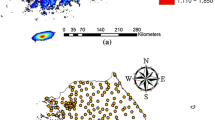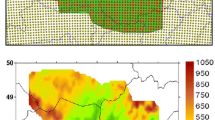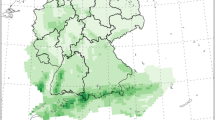Abstract
This study describes a two-step analogue statistical downscaling method for daily temperature and precipitation. The first step is an analogue approach: the “n” days most similar to the day to be downscaled are selected. In the second step, a multiple regression analysis using the “n” most analogous days is performed for temperature, whereas for precipitation, the probability distribution of the “n” analogous days is used to define the amount of precipitation. Verification of this method has been carried out for the Spanish Iberian Peninsula and the Balearic Islands. Results show good performance for temperature (BIAS close to 0.1 °C and mean absolute errors around 1.9 °C) and an acceptable skill for precipitation (reasonably low BIAS except in autumn with a mean of −18 %, mean absolute error lower than for a reference simulation, i.e. persistence and a well-simulated probability distribution according to two non-parametric tests of similarity).













Similar content being viewed by others
References
Abaurrea J, Asín J (2005) Forecasting local daily precipitation patterns in a climate change scenario. Clim Res 28:183–197
Balzer K (1991) Recent improvements in medium-range local weather forecasting in the Deutscher Wetterdienst. In: Lectures of the WMO training workshop on the interpretation of NWP products in terms of local weather phenomena and their verification, Wageningen, pp. 225–229
Brands S, Herrera S, San-Martin D, Gutierrez JM (2011) Validation of the ENSEMBLES global climate models over southwestern Europe using probability density functions, from a downscaling perspective. Clim Res 48(2–3):145–161. doi:f10.3354/cr00995g
Brunet M, Aguilar E, Saladíe O, Sigró J, López D (2001) The Spanish temperature series. Time variations and trends over the last 150 years. Geophysical Research Abstracts 3:GRA3 5333 76
Brunet M, Casado MJ, De Castro M, Galán P, López JA, Martín JM, Pastor A, Petisco E, Ramos P, Ribalaygua J, Rodríguez E, Sanz I, Torres L (2008) Generación de escenarios regionalizados de cambio climático para España. Centro de Publicaciones, Secretaría General Técnica. Ministerio de Medio Ambiente y Medio Rural y Marino. Spanish Meteorology Agency (AEMET), Madrid
Bürguer G (1996) Expanded downscaling for generating local weather scenarios. Clim Res 7:118–28
Capel-Molina JJ (2000) El Clima de la Península Ibérica. Ed. Ariel, Barcelona
Chastagnaret G, Gil-Olcina A (2006) Riesgo de inundaciones en el Mediterráneo Occidental. Collection de la Casa de Velásquez 95:115–130, ISSN 1132–734
Christensen JH, Carter TR, Rummukainen M et al (2007) Evaluating the performance and utility of regional climate models: the PRUDENCE project. Clim Change 81:1–6
Déqué M, Piedelievre JP (1995) High resolution climate simulations over Europe. Clim Dyn 11:321–339
Enke W, Spekat A (1997) Downscaling climate model outputs into local and regional weather elements by classification and regression. Clim Res 8:195–207
Fowler HJ, Blenkinsop S, Tebaldi C (2007) Linking climate change modelling to impacts studies: recent advances in downscaling techniques for hydrological modelling. Int J Clim 27:1547–1578
Gibergans Baguena J, Llasat MC, Martin Vide J (1995) Precipitaciones extremas en el área mediterránea. Riegos y drenajes XXI 11:27–34, ISSN 0213–3660
Giorgi F, Shields Brodeur C, Bates GT (1994) Regional climate change scenarios over the United States produced with a nested regional climate model. J Climate 7:375–399
Giorgi F, Francisco R (2001) Uncertainties in the prediction of regional climate change. Global Change and Protected Areas 9:127–139
Goodess CM, Anagnostopoulou C, Bárdossy A, Frei C, Harpham C, Haylock MR, Hundecha Y, Maheras P, Ribalaygua J, Schmidli J, Schmith T, Tolika K, Tomozeiu R, Wilby RL (2011) An intercomparison of statistical downscaling methods for Europe and European regions—assessing their performance with respect to extreme temperature and precipitation events. Climatic Research Unit Research Publication (CRURP) N.11, University of East Anglia, UK. http://www.cru.uea.ac.uk/cru/pubs/crurp/CRU_RP11.pdf
Hamill TM (1999) Hypothesis tests for evaluating numerical precipitation forecasts. Wea Forecasting 14:155–167
Hersbach H (2000) Decomposition of the continuous ranked probability score for ensemble prediction systems. Wea Forecasting 15:559–570
Herrmann JM (2008) Relevance of ERA40 dynamical downscaling for modeling deep convection in the Mediterranean Sea. Geophys Res Let 35:L04607
Hewitson BC, Crane RG (eds) (1994) Neural nets applications in geography. Kluwer Academic, Dordrecht
Holton J (2004) An introduction to dynamic meteorology, 4th edn. Academic, New York, p 535 pp
Huebener H, Cubasch U, Langematz U, Spangehl T, Niehörster F, Fast I, Kunze M (2007) Ensemble climate simulations using a fully coupled ocean–troposphere–stratosphere general circulation model. Phil Trans Roy Soc A 365:2089–210. doi:10.1098/rsta.2007.2078
Hu H, Oglesby RJ, Marshall S (2005) The simulation of moisture processes in climate models and climate sensitivity. J Climate 18:2172–2193. doi:10.1175/JCLI3384.1
Imbert A, Benestad R (2005) An improvement of analog model strategy for more reliable local climate change scenarios. Theor Appl Climatol 82:245–255. doi:10.1007/s00704-005-0133-4
Jansa A, Genoves A, Garcia-Moya JA (2000) Western Mediterranean cyclones and heavy rain. Part 1: Numerical experiment concerning the Piedmont flood case. Met Apps 7:323–333
John VO, Soden BJ (2007) Temperature and humidity biases in global climate models and their impact on climate feedbacks. Geoph Res Let 34:L18704. doi:10.1029/2007GL030429
Jones RG, Murphy JM, Noguer M, Keen B (1997) Simulation of climate change over Europe using a nested regional-climate model. II: Comparison of driving and regional model responses to a doubling of carbon dioxide. Q J R Meteorol Soc 123:265–292
Kruizinga S, Murphy AH (1983) Use of an analogue procedure to formulate objective probabilistic temperature forecasts in the Netherlands. Mon Wea Rev 111:2245–2254
Lazier JR, Pickart RS, Rhines PB (2001) Deep convection. In: Lazier JR (ed) Ocean circulation and climate. Observing and modelling the global ocean. Academic Press, London
Lopez-Bustins JA, Martin-Vide J, Sanchez-Lorenzo A (2008) Iberia winter rainfall trends based upon changes in teleconnection and circulation patterns. Glob Planet Change 63:171–176
Marsaglia G, Tsang WW, Wang J (2003) Evaluating Kolmogorov’s distribution. J Stat Softw 8:18
Martin E, Timbal B, Brun E (1997) Downscaling of general circulation model outputs simulation of the snow climatology of the French Alps and sensitivity to climate change. Clim Dyn 13:45–56
Martín-Vide J (2004) Spatial distribution of a daily precipitation concentration index in peninsular Spain. Int J Clim 24:959–971
Matulla C, Zhang X, Wang XL, Wang J, Zorita JE, Wagner S, von Storch H (2008) Influence of similarity measures on the performance of the analog method for downscaling daily precipitation. Clim Dyn 30:133–144
McBride JL, Ebert EE (2000) Verification of quantitative precipitation forecasts from operational numerical weather prediction models over Australia. Wea Forecasting 15:103–121
Mearns LO (1997) On the statistical evaluation of climate model experiments—comment. Clim Change 37:443–448
Murphy J (1999) An evaluation of statistical and dynamical techniques for downscaling local climate. J Climate 12:2256–2284
R Development Core Team (2010): R: a language and environment for statistical computing. R Foundation for Statistical Computing, Vienna, Austria. http://www.R-project.org. ISBN: 3-900051-07-0. Accessed 6 July 2011
Räisänen J (2007) How reliable are climate models? Tellus A 59:2–29. doi:10.1111/j.1600-0870.2006.00211.x
Roeckner E, Brokopf R, Esch M, Giorgetta M, Hagemann S, Kornblueh L (2006) Sensitivity of simulated climate to horizontal and vertical resolution in the ECHAM5 atmosphere model. J Climate 19:3771–3791
Scholz FW, Stephens MA (1987) K-sample Anderson-Darling tests. J Am Stat Assoc 399:918–924
Stauffer DR, Seaman NL (1990) Use of four-dimensional data assimilation in a limited-area mesoscale model. Part I: Experiments with synoptic-scale data. Mon Wea Rev 118:1250–1277
Sekhon JS (2010) Matching: multivariate and propensity score matching with balance optimization. R package version 4.7-11. http://CRAN.R-project.org/package=Matching. Accessed 6 July 2011
van der Linden P, Mitchell JFB (eds) 2009: ENSEMBLES: Climate change and its impacts: summary of research and results from the ENSEMBLES project. Met Office Hadley Centre, UK, 160 pp. http://ensembles-eu.metoffice.com/docs/Ensembles_final_report_Nov09.pdf. (see p 68). Accessed 10 Feb 2012
von Storch V, Zorita E, Cubasch U (1993) Downscaling of global climate change estimates to regional scales: an application to Iberian rainfall in wintertime. Am Meteorol Soc 6:1161–1171
von Storch V (1994) Inconsistencies at the interface of climate impact studies and global climate research. Max-Planck-Institut fur Meteorologie, Report no. 122, Hamburg
Weigel AP, Liniger MA, Appenzelle C (2006) The discrete Brier and ranked probability skill scores. Mon Weather Rev 118:135–124
Wilby RL, Wigley TML (1997) Downscaling general circulation model output: a review of methods and limitations. Prog Phys Geogr 21:530–548
Wilby RL, Wedgbrow CS, Fox HR (2004) Seasonal predictability of the summer hydrometeorology of the River Thames, UK. J Hydrol 295:1–16
Wilks DS (2005) Statistical methods in the atmospheric sciences, Chapter 7. Academic Press, San Diego
Woodcock F (1980) On the use of analogues to improve regression forecasts. Mon Wea Rev 108:292–297
Yu S, Eder B, Dennis R, Chu S-H, Schwartz SE (2006) New unbiased symmetric metrics for evaluation of air quality models. Atmos Sci Let 7:26–34
Zorita E, Hughes J, Lettenmaier D, Storch H (1993) Stochastic downscaling of regional circulation patterns for climate model diagnosis and estimation of local precipitation. Max-Planck-Institut fur Meteorologie, Report no. 109, Hamburg
Acknowledgments
This study was partly supported by the Ministry of Science and Innovation funding under the GENCEI project (contract no. CGL2005-06600-C03-03, 2006–2008). The authors thank the Spanish Meteorology Agency (Agencia Estatal de Meteorología – AEMET) for providing the observed data set and the European Centre for Medium-Range Weather Forecasts (ECMWF) for offering the ERA-40 reanalysis data (http://data-portal.ecmwf.int/data/d/era40_daily). We also thank Clare Goodess (Climate Research Unit, East Anglia University) for her help.
Author information
Authors and Affiliations
Corresponding author
Appendix
Appendix
An example will help to understand the proposed method and its justification (see Section 3.3.2). To simplify, in this example, m = 4, n = 4, and all the analogous days will have the same probability, π ij = 1/4. Table 1 shows the supposed observed precipitation (ρ ij ) of each analogous day (a ij ) and the preliminary precipitation estimate (Eq. 4).
Within these four problem days together, there would be a probability of 1 day with precipitation over 50 mm of 25 % (for x 1) + 25 % (for x 2) + 50 % (for x 4), so it is expected that 1 day of those four has a precipitation over 50 mm. However, no preliminary precipitation estimate reaches that amount, due to smoothing in the average. Likewise, the probability of no rain would be 50 % (for x 1) + 50 % (for x 2) + 100 % (for x 3), so it is expected that two of those 4 days are dry, while the preliminary precipitation estimate suggested only one, again due to averaging and smoothing.
To solve this problem, we pooled all n · m analogues (n analogues for each of all m days in the month) to construct a sample distribution, and obtained the final precipitation amount estimation from this joint probability distribution (Eq. 5). Sorting the m · n observed precipitation amounts (ρ ij ), the m final precipitation amounts are obtained by averaging each of the m groups of n sorted analogues. This way, 1 day over 50 mm and two dry days are obtained, and these final precipitation amounts are assigned to each of the problem days according to their preliminary precipitation amount estimates (see Table 2).
The final precipitation distribution is much more similar to the m · n analogue observed precipitation distribution than the preliminary precipitation distribution was. In addition, the extremes (high values and dry days) of that m · n analogue distribution are much better represented.
Rights and permissions
About this article
Cite this article
Ribalaygua, J., Torres, L., Pórtoles, J. et al. Description and validation of a two-step analogue/regression downscaling method. Theor Appl Climatol 114, 253–269 (2013). https://doi.org/10.1007/s00704-013-0836-x
Received:
Accepted:
Published:
Issue Date:
DOI: https://doi.org/10.1007/s00704-013-0836-x




